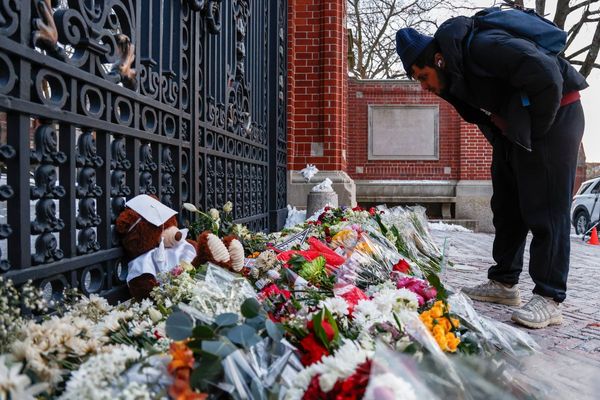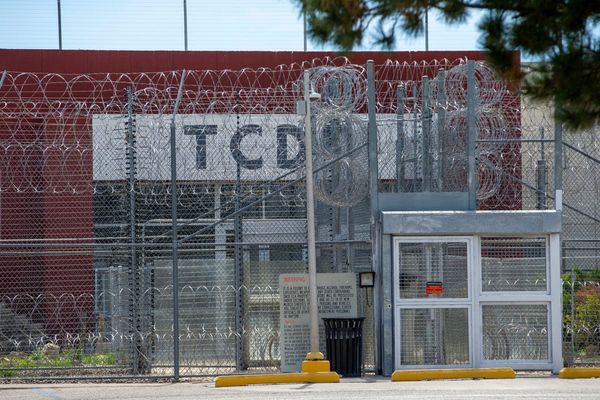MUSIC put Scotland on the radar of the teenage Janos Lang when he was growing up in Hungary. And it was music which helped him build a life here and embark on a plan to make life better for one of Scotland’s most isolated communities.
He had already been captivated by Irish and traditional music when he had first encountered it while accompanying his dad, a journalist and musician on tour outside Hungary, then under communist rule.
But it was when the small Hungarian town where he lived staged a Scottish weekend at the beginning of the 1990s that he really fell in love with it.
“My dad was a journalist in Hungary, and musician when he started his career,” he says. “My mum was a textile artist and photographer, all sorts of everything … it was quite a creative family. And because my dad was playing traditional music at the time – in in the 70s, 80s, when there was a big boom – he was allowed to go on the other side of the Iron Curtain to Denmark with his band. And he took me once or twice, and I think that left a big imprint on me as a young kid going to the West.”
“I was around seven or eight and was already playing music [the fiddle]. There were no cassettes of this music in Hungary and this was in the days before the internet so I had not heard this before. Was it Irish or Scottish? I couldn’t tell the difference … but I loved it.
“One of the big influences I had was my town did a Scottish weekend theme in 1991 or 1992 and there was a young band that was just mind-blowing to us, because they were combining Scottish music with more modern instruments. That band was Shooglenifty.

Lang’s mum was of Roma origin, and there had long been a Roma community in parts of Britain. Today, Glasgow’s Govanhill is home to the second-largest Roma community in the UK.
The Roma people have historically faced significant challenges. They were wanderers, without a country of their own. They were targeted, killed and enslaved in various parts of Europe in the early 18th century. The Holocaust Encyclopaedia details their persecution by the Nazi regime, which embarked on a genocide which killed more than 250,000 Romani people.
There is evidence of Romani people in Scotland as early as the 16th century. Many settled in Govanhill after the expansion of the EU in 2004, although some arrived earlier and looked for asylum here.
A Roma resident in Govanhill, Emilia Gaziova, wrote in the Greater Govanhill magazine in 2021: “Many in our community do not trust the state, due to painful history, demotivating experiences and mistrust passed down from previous generations.
“However, there are an increasing number of Roma who have chosen to overcome these barriers and are very successful in schools and at work, adopting a healthier lifestyle and helping others to achieve this.’’
However, it was not Glasgow but the south of England and then Aberdeenshire where Lang made his home when the travel restrictions in Hungary were lifted. His travels with his dad had encouraged him to consider a life in the West.
“When I think back, I remember that the things we treasured and brought back to Hungary from our trips were empty coke tins, ice cream wrappers, crisp packaging,” he says. “We didn’t have these at home. We brought these things back, basically rubbish. That’s how magical it was to go from east to west.”
He landed a job in Aberdeen and also spent some time living in Edinburgh before moving to Glasgow around 2016 when his wife landed a job in the city. He loved the music scene in Scotland and continued to play and occasionally tour.
It was when he moved to Glasgow that he decided to use music to celebrate and promote the Roma culture of those living in Govanhill. First he launched a charity – Ando Glaso (which means In Tune) – and then a regular festival, the third of which is being held next month.
"It became very clear from the start that everything we do is rooted in intangible cultural heritage,” says Lang. “That was always the drive behind Ando Glaso ... how can we use our own cultural heritage to support Roma people, to embed our people and our culture into the mainstream?
“That seems to be a challenge everywhere Roma people live. I’ve always thought that this is one of the biggest obstacles for Roma people to thrive, to develop and to be more part of the world around them.
“There’s not one Roma community, there are thousands of different little Roma groups living around Europe now, and that made these groups pretty much vulnerable to being thought of as a kind of vagabond, homeless, migrating people. There’s a kind of stigma.
“I guess 1000 years ago, the world wasn’t very understanding. If you didn’t arrive in Europe with a big army to cut a big chunk of land for yourself, then you were most likely a slave.
“That, unfortunately, was where most of our people fell under and that leaves a legacy. It creates a situation where, culturally and in many ways, you are disconnected from the world around you.’’
The result is that the Roma people can be slow to embrace their own culture, which they perceive as unpopular. Wherever they live the Roma people are known as musicians, but Lang found the music they were playing here was not from their own culture but was more generic pop music.
“The problem with that is that the Roma people don’t know the value of their own cultural heritage. They look at it as something that is not interesting for the public, that in many cases it is something that is better to hide. But there are strong, very identifiable elements of Roma culture that are still there that can be used to connect with people.”
There are economic as well as societal arguments for encouraging Roma people to promote their own culture.
“Music was one of the only services that the Roma people could provide. Through that they were invited into mainstream societies.
“Sometimes, even in modern days, a whole village will rely on one band that is able to play at every wedding, every funeral, everywhere … not just for the Roma, but for, the outside world. That is a very unique bridge and money earned through that way goes a lot further and is a lot more respected than money that’s just handed out to ‘poor’ people.
"Roma culture has been shaped very strongly by a culture of survival over these centuries. When we talk about gypsy music, it’s not just simply a beautiful art form that Roma people created for the sake of creating beautiful art forms. It had a very strong function of keeping these communities alive and paying for them.”
Ando Glaso has built its work on three main pillars. The first is the creative world and to create high-quality products and an understanding of how Roma culture can play a role in that world. Creative Scotland has helped with funding to help make that happen.
The second pillar is heritage.
Lang says: “We have a strong focus on intangible cultural heritage, which has become a hot topic these days internationally. We do as much of as possible in terms of researching intangible cultural heritage, especially what exists here in Scotland and how can we build on it? That’s where the festival actually started.”
This element of the charity’s work is supported by the National Lottery Heritage Fund and the festival serves as a showcase of all the work that’s been happening in this sphere.
Lang says: “It was very clear all of a sudden that there is a need – not just in Scotland or even the UK, but even internationally – for Roma-led cultural platforms.’’
The third pillar is youth work “because of the usual cliche, they are the future”. There is a lot of focus on encouraging young Roma people to emerge as leaders.
“That’s one of the biggest challenges as well for Roma all over the world. Roma leadership is very sparse. In Scotland, the opportunities are there. So it is very, very important for us to lobby for that, to be very grateful and to collaborate a lot with everybody. And at the same time, we also need to ask to be allowed to lead on it when we are ready.’’
The upcoming Ando Glaso Glasgow festival aims to share the best of Roma culture with a strong line-up of international performers, speakers and artists when it is staged on September 12 and September 13, anchored around five key strands: a youth festival, an international concert series, a short film competition, an arts and crafts fair, and a cultural symposium.
The youth festival, held at Elim Church, features R&B singer Lucie Bikarova, a Czech-born Roma superstar acclaimed for helping bring her traditional culture into mainstream music, and hip-hop star Bobby Blaze, dubbed the “Roma Snoop Dogg”. Both Lucie and Bobby will also perform at BAaD in the Glasgow Barras.
Other highlights include singer Marius de la Brasov from Romania, acclaimed multi-instrumentalist Tcha Limberger from Belgium, Glasgow-based Roma performers Zor, Del Artek, a gypsy jazz band with Roma, Polish and Scottish roots, and Ruva, who will bring the best in Roma music from Transylvania and Hungary.
A craft fair will feature the best of Roma and Traveller artworks, exhibitions, workshops and performance, and a special film festival and short film competition will take place with cash prizes available for the best three films, open to anyone from the Gypsy, Roma or Traveller communities across the UK.
A discussion event, Making Space: Roma Accessing Arts & Culture, will bring together leading thinkers, activists, and creatives from the Roma community and beyond.
The closing night of the festival will have a real Latin flavour, with the UK’s most authentic Cuban band, the Sambroso All Stars.
The organisers believe this will be the largest Roma cultural gathering ever held in Scotland – and the only UK event of its kind centred entirely on Roma arts, culture and heritage.
The festival has a strong story to tell the world about Roma culture but it also contains a message to the community itself, a message about self-confidence and taking control.
“The changes we want to see will come from leadership, from Roma themselves,” says Lang. “We’re really focusing on that a lot these days, advocating for it, and discussing it with other organisations and the Government, how to do that and how to achieve that. When we talk about our arts, culture, heritage, for example, we want that to be led by Roma people.
“Even on wider policy-making, we would like to see that rolled out by Roma people and discussed with Roma people, led by Roma people. We would like to form a Roma working group. This is a very new initiative.
“We only had like two meetings with a few people far, but we need to see lot of people stepping up and saying, ‘Okay, I want to lead on this. I want to work on this, and not just because it’s a job, but because I genuinely want to lead on that’. Especially for our young people, that leadership is going to be crucial to how well we are going to be able to collaborate with the world around us.”
Lang looks forward to the day when Scotland’s Roma community is more engaged with the outside world, less inward-looking, less concentrated in one area.
“There are things that we need to challenge, especially when talking about a young group of people were born or grew up in Scotland. We want them to be able to live outside of Govanhill. We want them to go to school, get a job, and be your next-door neighbour. That’s all … nothing special. Just to have path in front of them, not be afraid of it, and go out and do it.
“We see quite a lot of positive change in the chats we hear day to day with the people we work with. You can hear them like telling each other ‘I was in Aberdeen last week. Have you been to Aberdeen?’ The world starts opening up a bit more …
“The feedback we hear from Roma people is that the conditions and opportunities and situation of Roma in general is a lot better here in Scotland than it is in other parts of the UK.
“Of course, there are still challenges in terms of housing and healthcare and all that, but it is probably still better here than in other parts of the UK. Of course, in every country there are always some sort of issues that pop up from time to time, but I think generally speaking, in Scotland it has gone pretty well.
“It’s important to build on that, because if we do things right here in Scotland, we could be a very important good example for other countries.
“Many countries where Romani people were coming over would not have the same approach to us and that’s why we need to make it very clear and understandable why these things are important.
“What can be achieved if you pull together and put these initiatives together really well – the festival is just one of those. But I think it’s an example for the rest of the world if we do it right.
“This is the beauty about being in Scotland, because it’s a relatively small country and I didn’t find it difficult to talk to the Government, you know, whereas trying to do that in Westminster … it feels more like a big community where we can talk to each other and go, like, Okay, guys, let’s get this right.”
The Ando Glaso Roma Fest will be held on Saturday, September 12 and Sunday, September 13. Full details at andoglaso.org







